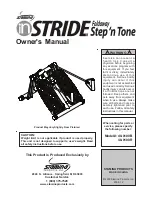
6
English
2. Directions for use
2.1
Important fundamental information
To achieve satisfactory results with a steam
cleaner, it is most important that the initial cleaning
stage is performed thoroughly. This means that
where detergents and other cleaning products have
been used for many years, the immediate objective
must be to strip away the layer that will have built
up. By using a steam cleaner, dirt is lifted off, as
described previously, and picked up by the cloth.
Depending upon the amount to be cleaned off, the
dirt will have been completely removed after the
cleaner has been applied 1 - 2 times. The result is a
floor surface that is free of streaks. The same
applies when cleaning windows. The steam cleaner
cannot remove large amounts of limescale directly.
A description of the procedure for successfully
removing these types of deposits is contained in
the section concerning the cleaning of bathroom
fittings.
2.2
Special notes on cleaning
Fabrics
Before steam-cleaning fabrics or textiles, we
recommend that first of all you carry out a test on
an inconspicuous part of the material. Apply plenty
of steam to the test area, and then allow the material
to dry out so that you can determine whether any
changes in colour or shape occur.
Coated or painted surfaces
When steam-cleaning kitchen cabinets or other
items of furniture, doors, parquet flooring, painted
or plastic-coated surfaces, please take into account
that waxes, furniture polish, plastic coatings or paint
may be dissolved or lifted off if they are subjected
to prolonged exposure to the steam jet. Apply only
small amounts of steam directly to these types of
surface, or clean them with a cloth to which the
steam has been applied first.
Glass surfaces / window panes
Glass surfaces may break if they are subjected to
uneven heating. Especially in the case of low
exterior temperatures, you should first of all spray
steam lightly over the whole glass surface in order
to even out any differences in temperature and to
avoid the build-up of tension on the surface of the
glass. Do not apply the steam jet directly to the
sealed parts of the window.
2.3
Regulating volume of steam with
rotary knob on main unit
•
If you are working with the standard accessories
or the iron, you can control the volume of steam
by adjusting the rotary knob on the main unit.
2.4
Regulating volume of steam with
handwheel on steam gun
•
If you are working with the standard accessories
you can regulate the volume of steam with the
handwheel on the steam gun. In this case the
rotary knob on the main unit is inoperative.
Note:
If the handwheel is set for a small volume of
steam, it is quite possible that steam may still be
expelled from the nozzle for a short interval after
the steam switch has been released and until the
pressure in the steam hose has dissipated. You can
release the pressure more quickly by turning the
steam volume control to a higher setting.
2.5
VAPOHYDRO rotary control knob
•
In washrooms or tiled areas, for example, you can
also flush the dirt away instead of wiping it off with
the cloth. This is achieved by varying the moisture
content of the steam by adjusting rotary knob on
the main unit. The greater the amount of moisture
in the steam, i.e. the more water there is in the
steam jet, the better the washing results will be.
If you turn the rotary knob all the way round to “+”,
a jet of hot water is discharged from the nozzle
giving the greatest flushing effect.
•
Use the VAPOHYDRO feature together with the
spot nozzle, for example, for cleaning the
bathroom.
•
If you are working with cloths (floor nozzle, hand
nozzle), set the VAPOHYDRO rotary control
knob to “–”, so that the steam jet contains as little
moisture as possible. This improves the ability of
the steam to loosen and dissolve the dirt.
Note: If you turn the VAPOHYDRO rotary control
knob to “+”, the boiler will empty more quickly.
Summary of Contents for Zephyr
Page 1: ...English 3 Français 12 Español 21 Zephyr 5 962 179 03 07 ...
Page 2: ......
Page 3: ...English 3 1 Starting the unit ...
Page 12: ...12 Français 1 Mise en service ...
Page 21: ...Español 21 1 Puesta en marcha del aparato ...
Page 30: ......
Page 31: ......







































